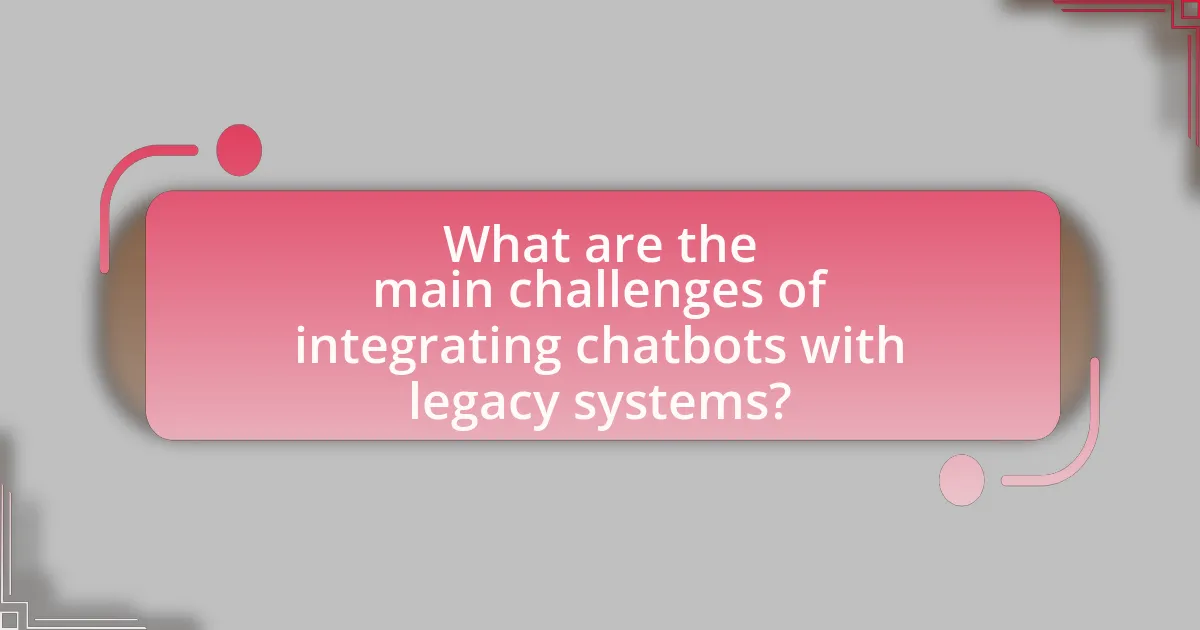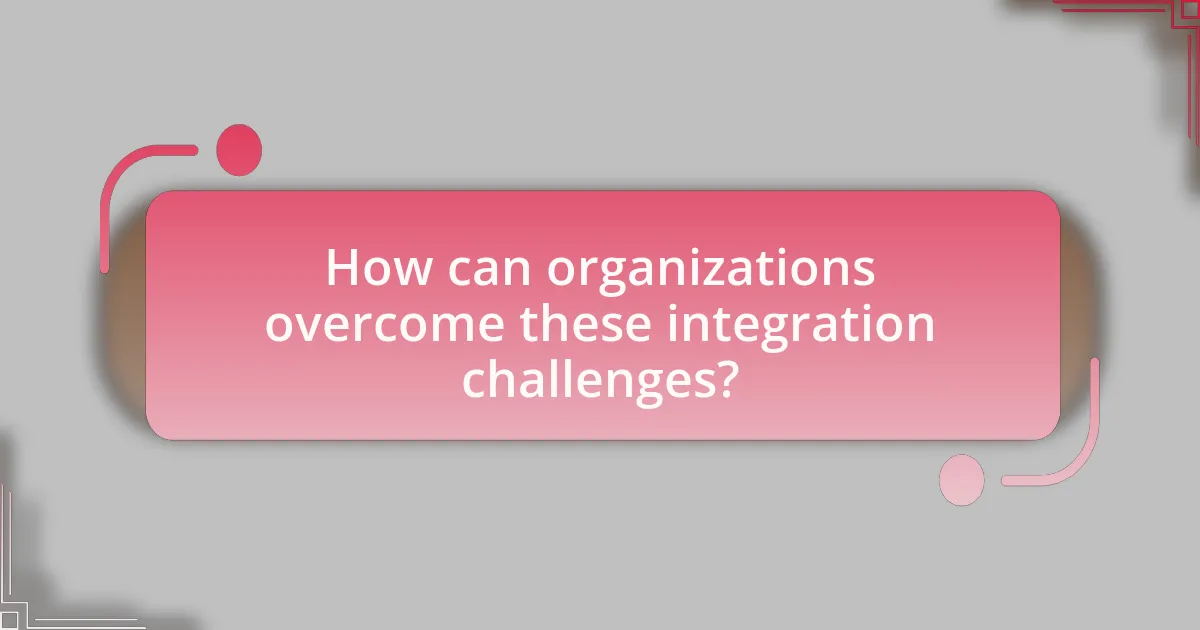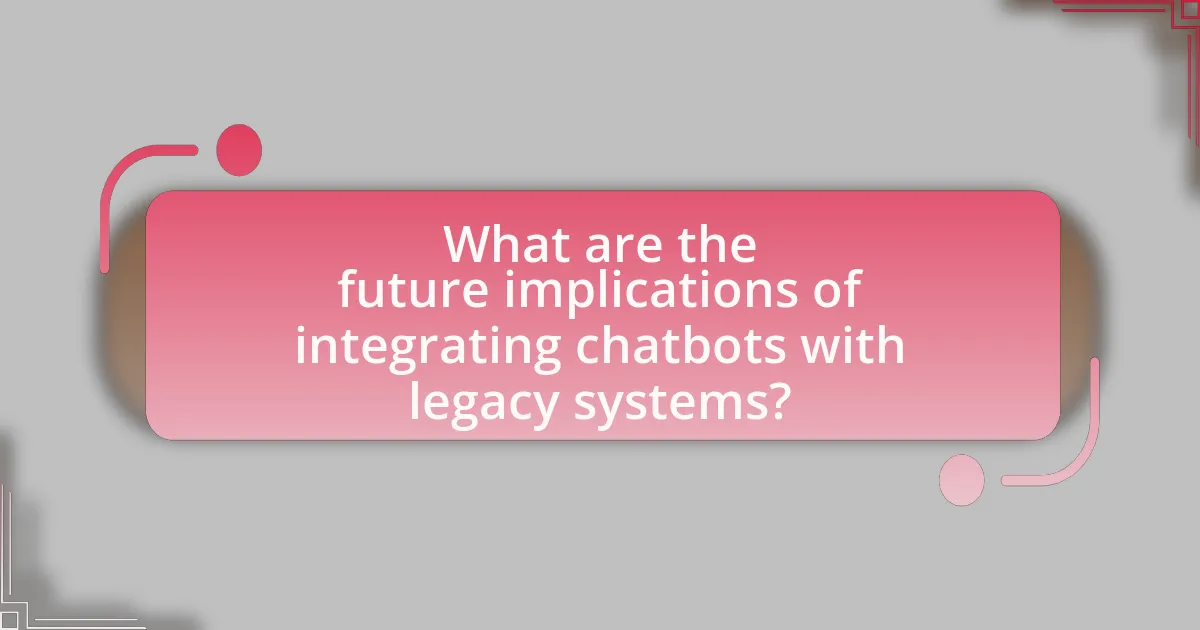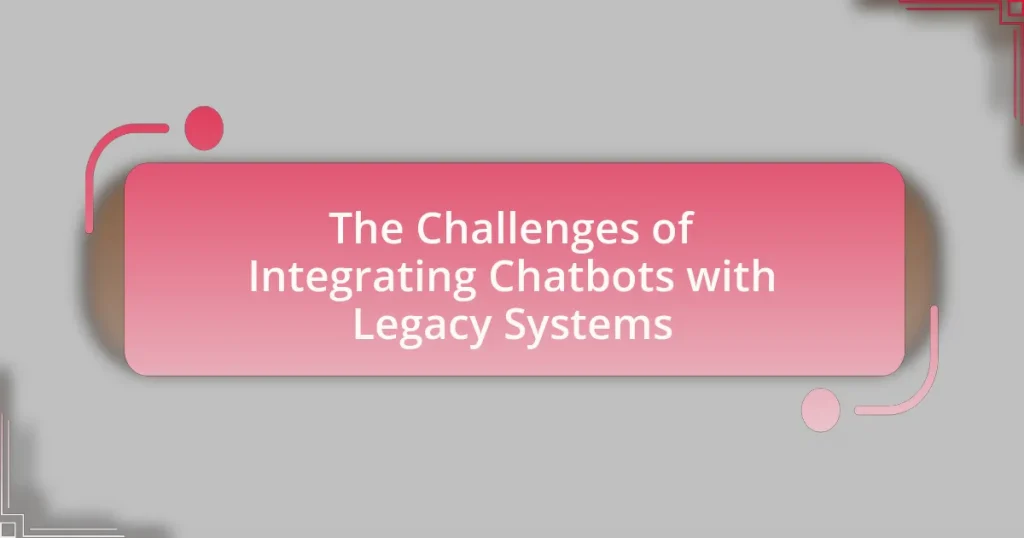The article focuses on the challenges of integrating chatbots with legacy systems, highlighting key issues such as compatibility problems, data silos, and limited APIs. It discusses the technical limitations imposed by outdated technologies, including difficulties in processing natural language and the impact on chatbot performance. The article also addresses security concerns associated with legacy systems and outlines strategies for overcoming integration challenges, such as adopting middleware solutions and conducting thorough system assessments. Additionally, it emphasizes the long-term benefits of successful integration, including improved operational efficiency and enhanced customer service.

What are the main challenges of integrating chatbots with legacy systems?
The main challenges of integrating chatbots with legacy systems include compatibility issues, data silos, and limited APIs. Compatibility issues arise because legacy systems often use outdated technologies that may not support modern chatbot frameworks, making integration complex. Data silos occur when information is trapped within legacy systems, hindering the chatbot’s ability to access and utilize relevant data for effective interactions. Additionally, limited APIs restrict the ability to connect chatbots with legacy systems, as many older systems lack the necessary interfaces for seamless communication. These challenges can significantly impede the successful deployment of chatbots in organizations relying on legacy technology.
Why is integration with legacy systems particularly difficult?
Integration with legacy systems is particularly difficult due to outdated technology, lack of documentation, and compatibility issues. Legacy systems often utilize obsolete programming languages and architectures, making it challenging to interface them with modern applications. Additionally, many legacy systems lack comprehensive documentation, which complicates understanding their functionality and data structures. Compatibility issues arise because newer systems may not support the protocols or data formats used by legacy systems, leading to integration failures. These factors collectively hinder seamless communication and data exchange between chatbots and legacy systems, making integration a complex task.
What technical limitations do legacy systems impose on chatbot integration?
Legacy systems impose significant technical limitations on chatbot integration, primarily due to outdated architectures and lack of interoperability. These systems often utilize proprietary technologies that do not support modern APIs or web services, making it difficult for chatbots to communicate effectively. Additionally, legacy systems may have limited processing power and memory, restricting the complexity of chatbot functionalities that can be implemented. Furthermore, data silos within legacy systems hinder the seamless flow of information, which is essential for chatbots to provide accurate and timely responses. These limitations are evidenced by studies indicating that over 70% of organizations face challenges in integrating new technologies with legacy systems, highlighting the widespread impact of these constraints on chatbot deployment.
How do outdated technologies affect the performance of chatbots?
Outdated technologies significantly hinder the performance of chatbots by limiting their ability to process natural language effectively and integrate with modern systems. Legacy systems often lack the necessary APIs and data structures that contemporary chatbots require for seamless communication and data retrieval. For instance, a study by Gartner indicates that 70% of organizations struggle with integrating AI solutions due to outdated infrastructure, which directly impacts the responsiveness and accuracy of chatbot interactions. Consequently, chatbots operating on outdated technologies may provide subpar user experiences, leading to decreased customer satisfaction and engagement.
What are the common compatibility issues faced during integration?
Common compatibility issues faced during integration include data format mismatches, API incompatibilities, and differing software architectures. Data format mismatches occur when the legacy system uses outdated or proprietary formats that the chatbot cannot interpret, leading to errors in data exchange. API incompatibilities arise when the chatbot’s integration requirements do not align with the legacy system’s available APIs, which can hinder communication between the two systems. Additionally, differing software architectures, such as monolithic versus microservices-based systems, can complicate integration efforts, as they may require significant re-engineering to ensure seamless interaction. These issues are prevalent in many integration projects, as highlighted by industry reports indicating that over 60% of integration efforts encounter such challenges.
How do data formats and protocols create barriers to integration?
Data formats and protocols create barriers to integration by establishing incompatible standards that prevent seamless communication between systems. For instance, legacy systems often utilize outdated data formats like XML or proprietary protocols, while modern applications may rely on JSON and RESTful APIs. This discrepancy leads to difficulties in data exchange, as systems cannot interpret or process information correctly without appropriate conversions. Furthermore, the lack of standardized protocols can result in increased development time and costs, as developers must create custom solutions to bridge these gaps.
What role does system architecture play in integration challenges?
System architecture plays a critical role in integration challenges by determining how different components of a system interact and communicate. A well-defined system architecture facilitates seamless integration by providing clear protocols and interfaces, while a poorly designed architecture can lead to compatibility issues, data silos, and increased complexity. For instance, legacy systems often have rigid architectures that do not easily accommodate modern technologies like chatbots, resulting in significant integration hurdles. Studies have shown that 70% of integration projects fail due to architectural mismatches, highlighting the importance of aligning system architecture with integration goals.
What are the security concerns associated with integrating chatbots and legacy systems?
Integrating chatbots with legacy systems raises significant security concerns, primarily due to vulnerabilities in outdated technology. Legacy systems often lack modern security features, making them susceptible to cyberattacks such as data breaches and unauthorized access. For instance, a report by IBM indicates that 60% of data breaches involve vulnerabilities in legacy systems, highlighting the risks associated with their integration. Additionally, chatbots may inadvertently expose sensitive data if not properly secured, as they often require access to personal and confidential information to function effectively. This combination of outdated security measures and the potential for data exposure creates a critical risk landscape when integrating chatbots with legacy systems.
How can vulnerabilities in legacy systems impact chatbot security?
Vulnerabilities in legacy systems can significantly compromise chatbot security by providing entry points for cyberattacks. Legacy systems often lack modern security features, making them susceptible to exploits such as SQL injection, cross-site scripting, and unauthorized access. For instance, a study by the Ponemon Institute found that 60% of organizations experienced a data breach due to vulnerabilities in legacy systems, which can directly affect the integrity and confidentiality of data processed by chatbots. Consequently, if a chatbot is integrated with a vulnerable legacy system, attackers can manipulate the chatbot’s responses, access sensitive information, or disrupt services, thereby undermining user trust and organizational security.
What measures can be taken to enhance security during integration?
To enhance security during integration, organizations should implement robust authentication mechanisms, such as multi-factor authentication (MFA), to verify user identities. This measure significantly reduces the risk of unauthorized access, as MFA requires users to provide multiple forms of verification, making it harder for attackers to compromise accounts. Additionally, employing encryption protocols for data in transit and at rest protects sensitive information from interception and unauthorized access. According to a study by the Ponemon Institute, organizations that utilize encryption experience 50% fewer data breaches, underscoring its effectiveness in safeguarding data during integration processes. Regular security audits and vulnerability assessments should also be conducted to identify and mitigate potential security risks, ensuring that integration points remain secure against evolving threats.

How can organizations overcome these integration challenges?
Organizations can overcome integration challenges with legacy systems by adopting a phased integration approach that includes thorough assessment, strategic planning, and leveraging middleware solutions. This method allows organizations to evaluate existing systems, identify compatibility issues, and develop a clear roadmap for integration. For instance, using middleware can facilitate communication between chatbots and legacy systems without requiring extensive modifications to the existing infrastructure, thus reducing implementation time and costs. According to a study by Gartner, organizations that utilize middleware for system integration can achieve up to a 30% reduction in integration costs and a 50% decrease in time to market for new services.
What strategies can be employed to facilitate smoother integration?
To facilitate smoother integration of chatbots with legacy systems, organizations can employ strategies such as adopting middleware solutions, utilizing APIs, and conducting thorough system assessments. Middleware solutions act as intermediaries that enable communication between the chatbot and legacy systems, thus simplifying data exchange. Utilizing APIs allows for standardized interactions, making it easier to connect disparate systems. Conducting thorough system assessments helps identify compatibility issues and integration points, ensuring that the integration process is efficient and effective. These strategies are supported by industry practices that emphasize the importance of interoperability and system compatibility in successful technology integration.
How does adopting middleware solutions help in integration?
Adopting middleware solutions facilitates integration by acting as a bridge that enables communication between disparate systems. Middleware streamlines data exchange and process coordination, allowing legacy systems to interact with modern applications seamlessly. For instance, middleware can translate data formats and protocols, ensuring compatibility between systems that otherwise would not communicate effectively. This capability is crucial in environments where chatbots need to access and utilize data from legacy systems, thereby enhancing functionality and user experience.
What role does API development play in overcoming integration hurdles?
API development plays a crucial role in overcoming integration hurdles by providing standardized interfaces that facilitate communication between disparate systems. These interfaces enable chatbots to interact seamlessly with legacy systems, which often use outdated protocols and data formats. By utilizing APIs, developers can abstract the complexities of legacy systems, allowing for smoother data exchange and functionality integration. For instance, a study by MuleSoft in 2020 found that organizations leveraging APIs reported a 50% reduction in integration time, demonstrating the effectiveness of API development in streamlining processes and enhancing interoperability.
What best practices should organizations follow during integration?
Organizations should follow a structured approach during integration to ensure successful outcomes. Key best practices include conducting thorough assessments of existing legacy systems to identify compatibility issues, establishing clear communication channels among stakeholders to facilitate collaboration, and implementing incremental integration strategies to minimize disruptions. Additionally, organizations should prioritize user training and support to enhance adoption rates and continuously monitor performance metrics to identify areas for improvement. These practices are supported by industry research indicating that structured integration processes lead to higher success rates in technology adoption and user satisfaction.
How can thorough testing mitigate integration risks?
Thorough testing mitigates integration risks by identifying and resolving issues before deployment. By conducting comprehensive tests, such as unit, integration, and system testing, organizations can ensure that the chatbot interacts correctly with legacy systems, preventing potential failures. For instance, a study by the National Institute of Standards and Technology found that effective testing can reduce software maintenance costs by up to 40%, highlighting the importance of early detection of integration issues. This proactive approach minimizes disruptions and enhances system reliability, ultimately leading to smoother integration processes.
What training is necessary for staff to manage integration effectively?
Staff managing integration effectively requires training in systems analysis, programming languages relevant to the legacy systems, and understanding of API (Application Programming Interface) protocols. This training equips staff with the necessary skills to analyze existing systems, develop integration solutions, and ensure seamless communication between chatbots and legacy systems. For instance, knowledge of RESTful APIs and data formats like JSON or XML is crucial for successful integration, as these are commonly used in connecting disparate systems. Additionally, training in project management methodologies can enhance staff’s ability to oversee integration projects, ensuring they are completed on time and within budget.

What are the future implications of integrating chatbots with legacy systems?
Integrating chatbots with legacy systems will likely enhance operational efficiency and customer engagement while posing challenges related to data compatibility and system integration. As organizations increasingly adopt chatbots for customer service and operational tasks, the integration with existing legacy systems can streamline processes, reduce response times, and improve user experiences. However, the complexity of legacy systems often leads to difficulties in data sharing and interoperability, which can hinder the full potential of chatbot capabilities. For instance, a study by McKinsey & Company indicates that companies that successfully integrate AI technologies, including chatbots, with their existing systems can see productivity improvements of up to 40%. Thus, while the future implications of this integration are promising in terms of efficiency and customer satisfaction, they also necessitate careful planning and investment in technology to address integration challenges.
How will advancements in technology influence integration processes?
Advancements in technology will significantly enhance integration processes by enabling more seamless communication between chatbots and legacy systems. For instance, the development of Application Programming Interfaces (APIs) and middleware solutions allows for easier data exchange and interoperability, reducing the complexity of integrating modern chatbots with older systems. According to a report by Gartner, organizations that leverage advanced integration technologies can achieve up to a 30% reduction in integration time and costs, demonstrating the tangible benefits of these advancements. Furthermore, the rise of cloud computing facilitates scalable integration solutions, allowing businesses to adapt their systems more efficiently as technology evolves.
What emerging technologies could simplify chatbot integration with legacy systems?
Emerging technologies that could simplify chatbot integration with legacy systems include Application Programming Interfaces (APIs), low-code/no-code platforms, and artificial intelligence (AI) middleware. APIs facilitate communication between chatbots and legacy systems by providing standardized methods for data exchange, which can significantly reduce integration complexity. Low-code/no-code platforms enable developers and non-developers alike to create integrations without extensive coding knowledge, streamlining the process of connecting chatbots to existing systems. AI middleware acts as a bridge, allowing chatbots to interpret and process data from legacy systems more effectively, enhancing their functionality and user experience. These technologies collectively address the challenges of compatibility and resource constraints often associated with legacy systems.
How might the evolution of legacy systems impact future integrations?
The evolution of legacy systems may significantly hinder future integrations by creating compatibility issues with modern technologies. As legacy systems often rely on outdated architectures and programming languages, their inability to seamlessly interface with contemporary platforms can lead to increased integration costs and extended project timelines. For instance, a study by Gartner indicates that 70% of organizations face challenges in integrating legacy systems with new applications, primarily due to these compatibility barriers. Consequently, organizations may need to invest in middleware solutions or extensive system overhauls to facilitate effective communication between legacy systems and modern applications, impacting overall operational efficiency.
What are the long-term benefits of successful integration?
Successful integration of chatbots with legacy systems leads to enhanced operational efficiency and improved customer satisfaction. By streamlining processes, organizations can reduce response times and minimize errors, resulting in a more effective service delivery. For instance, a study by McKinsey found that companies implementing automation and integration strategies can achieve productivity gains of 20-30%. Additionally, successful integration allows for better data utilization, enabling personalized customer interactions and informed decision-making. This data-driven approach can increase customer retention rates, as personalized experiences are linked to higher satisfaction levels.
How can improved customer service be achieved through effective integration?
Improved customer service can be achieved through effective integration by ensuring seamless communication between chatbots and legacy systems. This integration allows chatbots to access real-time data, enabling them to provide accurate and timely responses to customer inquiries. For instance, when a chatbot is integrated with a customer relationship management (CRM) system, it can retrieve customer history and preferences, leading to personalized interactions. Research indicates that companies utilizing integrated systems experience a 20% increase in customer satisfaction due to faster response times and more relevant information being provided. Thus, effective integration directly enhances the quality of customer service by streamlining processes and improving the overall customer experience.
What competitive advantages can organizations gain from integrating chatbots with legacy systems?
Organizations can gain significant competitive advantages from integrating chatbots with legacy systems by enhancing operational efficiency and improving customer engagement. This integration allows for streamlined processes, as chatbots can automate routine tasks and provide instant responses to customer inquiries, reducing the workload on human staff. For instance, a study by McKinsey found that automation can increase productivity by up to 40%, enabling organizations to allocate resources more effectively. Additionally, chatbots can access and utilize data from legacy systems to deliver personalized customer experiences, which can lead to higher customer satisfaction and retention rates. According to a report by Gartner, organizations that implement AI-driven customer service solutions, including chatbots, can achieve a 25% increase in customer satisfaction scores. Thus, the integration of chatbots with legacy systems not only optimizes internal operations but also enhances the overall customer experience, providing a clear competitive edge.
What practical tips can organizations implement for successful integration?
Organizations can implement several practical tips for successful integration of chatbots with legacy systems. First, conducting a thorough assessment of existing legacy systems is essential to identify compatibility issues and integration points. This assessment should include evaluating the architecture, data formats, and communication protocols used by the legacy systems.
Next, organizations should prioritize the use of middleware solutions that facilitate communication between chatbots and legacy systems, enabling seamless data exchange. Middleware can help bridge the gap between different technologies, ensuring that chatbots can access and utilize data from legacy systems effectively.
Additionally, organizations should invest in training their staff on both the chatbot technology and the legacy systems to ensure smooth operation and troubleshooting. This training can enhance user adoption and minimize resistance to change.
Finally, implementing a phased integration approach allows organizations to test and refine the integration process incrementally, reducing risks and ensuring that any issues can be addressed promptly. This method has been shown to improve overall integration success rates by allowing for adjustments based on real-time feedback.










